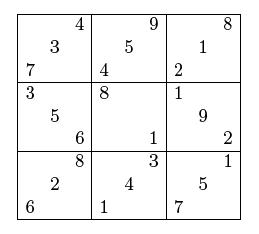HDU 3111 Sudoku(数独,还是深搜)
2016-05-07 21:30
211 查看
Sudoku
Time Limit: 2000/1000 MS (Java/Others) Memory Limit: 32768/32768 K (Java/Others)Total Submission(s): 464 Accepted Submission(s): 302
Problem Description
A Sudoku puzzle, once solved, is a 9x9 grid of digits organized as a 3x3 grid of smaller 3x3 units. Each of the nine rows must contain every positive digits exactly once, as do each column and also each 3x3 unit. The puzzle is to start from a partially filled
9x9 grid and to fill in the remaining cells using only logic. The puzzle maker usually makes sure that the solution will be unique and that it can be reached using deduction only, without guessing.

This number placing game is gaining popularity in the west, and every second newspaper publishes weekly instances of the puzzle. Somewhere at the head of one such newspaper, someone decided that buying individual instances from a puzzle maker would be too expansive,
and instead decided to steal puzzles from other newspapers and also to print randomly generated Sudoku-like grids.
One week later, his assistant gets stuck with the job of printing the solution to the Sudoku puzzles his boss previously published. Unfortunately, his boss doesn’t have those solutions, the randomly generated problems don’t have any solution, and he doesn’t
even remember which is which. In despair, the assistant calls for your help.
Input
The first line of the input will contain the number of test cases. Each test case will consist of a 9 by 9 grid of characters, where each character will either be ‘?’ or a digit between 1 and 9 inclusively.
Output
For each test case, you must print back the grid to the standard input, replacing each question mark with an appropriate digit to solve the Sudoku. If a test case does not allow any solution, output ”impossible” instead of a completed grid. If a test case do
allow a solution, you can assume that the solution will be unique, and that theoretically it could be reached without guessing.
Test cases are separated by “---” both in the input and in the output.
Sample Input
3 ??4??9??8 ?3??5??1? 7??4??2?? 3??8??1?? ?5?????9? ??6??1??2 ??8??3??1 ?2??4??5? 6??1??7?? --- ??4??9??8 ?3??5??1? 7??4??2?? 3??8??1?? ?5?????9? ??6??1??2 ??8??3??1 62??4??5? 6??1??7?? --- 3?1????76 7??9????? 2?5?3???? ?????64?1 ???2?1??? 1?25????? ????8?9?3 ?????9??4 51????7?8
Sample Output
264319578 839257416 715486239 372894165 451632897 986571342 548763921 127948653 693125784 --- impossible --- 391452876 764918532 285637149 953876421 678241395 142593687 426785913 837169254 519324768
Source
IPCP 2005 Northern Preliminary
for Northeast North-America
原题链接:http://acm.hdu.edu.cn/showproblem.php?pid=3111
还是数独,和以前一题差不多,也是数独,链接/article/7548655.html
但这题更加容易一点了
AC代码:
#include <iostream>
#include <cstring>
using namespace std;
int a[10][10];
int sum;
typedef struct Node
{
int x,y;
};
Node node[100];
bool flag;
bool OK(int p,int x)//在第p个位置放x
{
for(int i=0; i<9; i++)
{
if(a[node[p].x][i]==x||a[i][node[p].y]==x)
return false;
}
int xx=node[p].x/3*3;
int yy=node[p].y/3*3;
for(int i=xx; i<xx+3; i++)
for(int j=yy; j<yy+3; j++)
if(a[i][j]==x)
return false;
return true;
}
void DFS(int step)
{
if(step==sum)
{
for(int i=0; i<9; i++)
{
for(int j=0; j<9; j++)
cout<<a[i][j];
cout<<endl;
}
flag=true;
}
if(flag)
return;
for(int i=1; i<=9; i++)
{
if(OK(step,i))
{
a[node[step].x][node[step].y]=i;
DFS(step+1);
a[node[step].x][node[step].y]=0;
}
}
}
int main()
{
int n;
cin>>n;
char c,ch[5];
sum=0;
for(int ii=1; ii<=n; ii++)
{
sum=0;
for(int i=0; i<9; i++)
{
for(int j=0; j<9; j++)
{
cin>>c;
if(c=='?')
{
a[i][j]=0;
node[sum].x=i;
node[sum].y=j;
sum++;
}
else
a[i][j]=c-'0';
}
}
if(ii<n)
cin>>ch;
flag=false;
DFS(0);
if(!flag)
cout<<"impossible"<<endl;
if(ii<n)
cout<<"---"<<endl;
}
return 0;
}
相关文章推荐
- YJX_rxjh_09_2.5.1
- linux JDK安装(一)
- el表达式及jstl标签库
- template详解
- windos系统下通过优盘安装Ubuntu14.04系统
- 如何查看手机里的.db数据库文件
- android:screenOrientation属性
- java 输入/输出
- PowerDesigner 逆向工程 unable to list the tables
- Object-c------NSSet的简单介绍
- spring播放器详细设计说明书(一)
- hdu1010 扩展KMP求字符串最小循环节
- CoreThink主题开发(八)使用H-ui开发博客主题之用户登录之前及登录之后
- traits简单认识
- linux find 命令忽略某个或多个子目录的方法
- 双目视觉简介
- 05Android Studio使用插件推荐
- 容器类之 unordered_map
- 墓碑移动最短路求解问题
- FZU Problem 2230 翻翻棋
